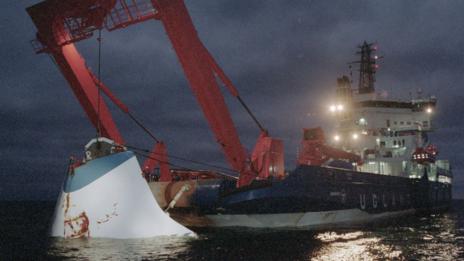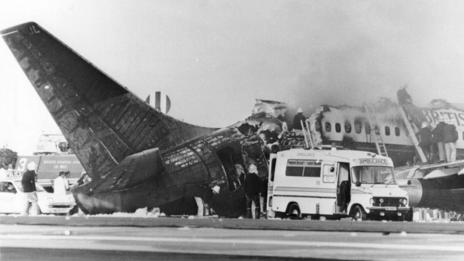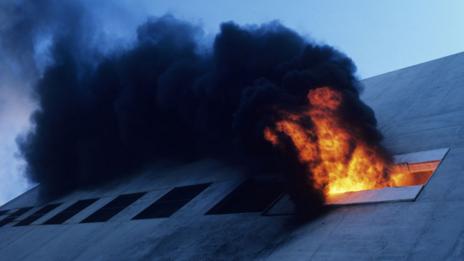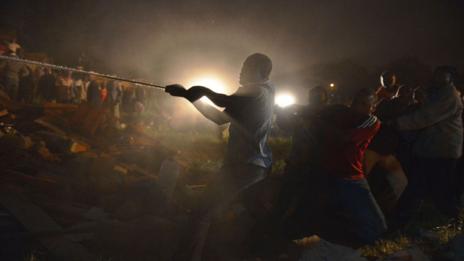In a catastrophic event, most people fail to do the one thing that would save their life, says Michael Bond. [source] BBC – Future – How to survive a disaster.
At seven o’clock in the evening of 27 September 1994, the cruise ferry MS Estonia left Tallin with 989 people on board, heading for Stockholm through the Baltic Sea. It never got there. Six hours into the journey, pushing through a force nine gale, the bow door broke open and the ferry started taking on water. Within an hour it had sunk, taking with it 852 of its passengers and crew.
What happened? One person who knows the answer is John Leach, a military survival instructor who researches behaviour in extreme environments at the University of Portsmouth. He has studied the actions of survivors and victims from dozens of disasters around the world over several decades (and as it happens he was present at one of them, the fire at King’s Cross underground station on 18 November 1987 which killed 31 people). He has found that in life-threatening situations, around 75% of people are so bewildered by the situation that they are unable to think clearly or plot their escape. They become mentally paralysed. Just 15% of people on average manage to remain calm and rational enough to make decisions that could save their lives. (The remaining 10% are plain dangerous: they freak out and hinder the survival chances of everyone else.)Even given the speed of tragedy, the stormy sea and the length of time it took rescuers to arrive (a full-scale emergency was only declared half an hour after the sinking), survival experts were astonished at the high death toll. It appears that many people drowned because they did nothing to save themselves. “A number of people… seem to have been incapable of rational thought or behaviour because of their fear,” concluded the official report into the accident. “Others appeared petrified and could not be forced to move. Some panicking, apathetic and shocked people were beyond reach and did not react when other passengers tried to guide them, not even when they used force or shouted at them.”

The bow of sunken ferry MS Estonia, on which more than 800 people died in 1994 (Getty Images)
Stories about survival often focus on the 15%, and what is so special about them that helps them stay alive. But Leach thinks this is the wrong question. Instead, we should be asking, why do so many people die when they need not, when they have the physical means to save themselves? Why do so many give up, or fail to adjust to the unfolding crisis? In most disaster scenarios, he says, you don’t need special skills to survive. You just need to know what you should do. “My role as a combat survival instructor is to teach people how to survive. My role as a psychologist is to teach people not to die.”
Emergency exit
We haven’t always had a clear picture of what people really do in emergencies. Engineers designing evacuation procedures used to assume that people respond immediately when they hear an alarm, smell smoke or feel their building shake or their boat begins to list.
Yet as cases in recent decades began to show, the real challenge is getting them to move quickly enough. On 22 August 1985, 55 people died in a Boeing 737 on the runway at Manchester Airport in the UK after the plane, which was bound for Corfu, suffered engine failure during take-off. The government’s Air Accident Investigations Branch reported: “Perhaps the most striking feature of this accident was the fact that although the aircraft never became airborne and was brought to a halt in a position which allowed an extremely rapid fire-service attack on the external fire, it resulted in 55 deaths. The major question is why the passengers did not get off the aircraft sufficiently quickly.”

Passenger behaviour in a fatal fire at Manchester Airport in the 1980s puzzled experts (Getty Images)
Rather than madness, or an animalistic stampede for the exits, it is often people’s disinclination to panic that puts them at higher risk.
One of the most graphic examples of crowd passivity in recent times occurred in New York’s Twin Towers after the hijacked planes hit them on 9/11. You’d have thought those who survived the initial impact would have headed for the nearest exit pretty quickly. Most did the opposite: they prevaricated. Those who eventually got out waited six minutes on average before moving to the stairs, and some hung around for half an hour, according to a study by the US National Institute of Standards and Technology (NIST). Unprepared for what was happening to them, they either carried on as normal or hung around to see what would happen, waiting for others to move first. One study found that half of those who survived delayed before trying to escape, making phone calls, tidying things into drawers, locking their office door, going to the toilet, completing emails, shutting down their computer, changing their shoes. One woman accustomed to bicycling to work even returned to her office to change into her tracksuit before trying to leave.
Survival mode
The prevailing psychological explanation for these kinds of behaviours – passivity, mental paralysis or simply carrying on as normal in the face of a crisis – is that they are caused by a failure to adapt to a sudden change in the environment. Survival involves goal-directed behaviour: you feel hungry, you look for food; you feel isolated, you seek companionship. Normally, this is straightforward (we know how to find food or companions). But in a new, unfamiliar environment, particularly a stressful one such as a sinking ship or a burning aircraft, establishing survival goals – where the exit is and how to get to it – requires a lot more conscious effort.

(Getty Images)
“In emergencies, quite often events are happening faster than you can process them,” explains Leach. The situation outruns our capacity to think our way out of it. Jerome Chertkoff, a social psychologist at Indiana University, puts it another way: “Being in a situation where your life is in danger increases your emotional arousal, and high arousal causes people to limit the number of alternatives they consider. That can be bad when trying to determine a course of action, since you may never consider the option most likely to result in escaping safely.”
This explains why in emergencies people often fail to do things that under normal circumstances would seem obvious. So the only reliable way to shortcut this kind of impaired thinking, most survival experts agree, is by preparing for an emergency in advance. “Practice makes actions automatic, without [the need for] detailed thinking,” says Chertkoff. This means making a mental note of the fire exits when you go to the cinema (and imagining yourself using them), reading the evacuation guidance on the back of the door when you stay in a hotel, and always listening to aircraft safety briefings however frequent a flyer you are. “Every time I go on a boat the first thing I do is find out where my lifeboat station is, because then if there is a problem I just have to respond, I don’t have to start thinking about it,” says Leach. Typically, survivors survive not because they are braver or more heroic than anyone else, but because they are better prepared.

Check your exits beforehand – you may not have the sense to in a crisis (Thinkstock)
What about how you deal with other people? No matter how well-primed you are, one aspect of emergency situations will always be out of our control: how those around us behave. Here, too, the scientific understanding is at odds with common wisdom or what we are likely to read in the media.
Commentators often highlight the supposed stupidity or madness of crowds during disasters – a stampede of pilgrims, the crush of a football crowd, the blind scramble for the exits in a burning nightclub. In reality, this is rarely what happens. Research shows that in most scenarios, groups of people are more likely to help each other than hinder. “In emergencies, the norm is cooperation,” says Chris Cocking, who studies crowd behaviour at the University of Brighton. “Selfish behaviour is very mild and tends to be policed by the crowd rather than spreading.”

Paul Dadge helping injured passenger Davinia Turrell after the London bombings of 2005 – one of the defining images of the attack (Gareth Cattermole/Getty Images)
Take the suicide bombings on London’s transport system on 7 July 2005, which killed 52 and injured more than 700. For several hours, hundreds of passengers were trapped in smoky underground tunnels with no way of knowing if they would be rescued, nor if further explosions were imminent. Amid this chaos, most people were highly cooperative and helpful, according to survivors interviewed by Cocking, John Drury at the University of Sussex and Steve Reicher at the University of St Andrews. Psychologists call this response “collective resilience”: an attitude of mutual helping and unity in the middle of danger.
Stronger together
Drury, Cocking and Reicher have documented many examples of collective resilience. In 2008, they talked to survivors of 11 mass tragedies or incidents from the previous four decades, including the 2001 Ghana football stadium crush in which 126 people died while trying to escape through locked exits, and the sinking of the cruise ship Oceanos off South Africa in 1991 (when remarkably all 500-odd passengers survived). In each case, group solidarity was more prevalent than selfishness. Cocking thinks that people’s tendency to cooperate during emergencies increases the chances of survival for everyone. “Individually, the best thing tactically is to go along with the group interest. In situations where everyone acts individually, which are very rare, that actually decreases effective group evacuation.”

In a crisis, people are more likely to help each other than be selfish (Getty Images)
Still, some emergencies can be so disorientating that cooperation may be beyond some people. For a dramatic example of how differently people behave when their life is on the line, consider the story of the British-Irish Atlantic Odyssey rowing team who in January 2012 attempted to cross the ocean east to west in a record-breaking 30 days. After 28 days, a freak wave capsized their boat while they were still 500 miles (800 kilometres) from their destination in Barbados. According to Mark Beaumont, an adventurer and broadcaster who was part of the six-strong crew, they would all have drowned had several of them not dived repeatedly under the upturned hull to free the life raft and retrieve the emergency beacon, GPS tracker, satellite phone, fresh water and food.
Deep shock
But not all of the crew reacted so rationally. “A couple of the guys went into pretty deep shock,” he recalls. “One of them could barely get a word out. He just shut his eyes and shut down.” Later, this colleague, who was a strong rower, explained to Beaumont that he had become overwhelmed by the situation. “I was completely out of my league,” he told him. “I thought the best thing to do was take up as little room as possible in the life-raft, shut my eyes and wait for it to pass, whether that was to die or be rescued.”
The chances are you will never find yourself in a disaster situation. But it’s a good idea to imagine that you will: to be aware that there are threats out there, and that you can prepare for them, without sliding into paranoia. “All you have to do is ask yourself one simple question,” says Leach. “If something happens, what is my first response? Once you can answer that, everything else will fall into place. It’s that simple.”
[source] BBC – Future – How to survive a disaster.
